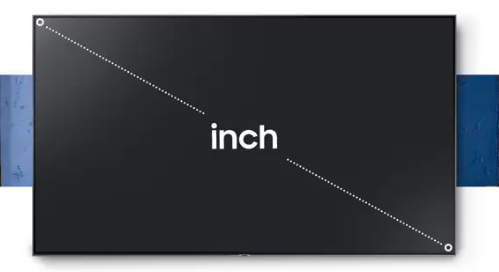
How to Choose the Best TV Screen Size
Are you looking to buy or book a TV rental but not sure what size to go for? Many of us have asked this question before, and to spare you from the trouble, we’re here to guide you through. We’ll teach you how to check TV sizes to see what fits your home, event, office, or anywhere you plan to use it.
Take note that picking the right TV size is very important to give you and your audience the best viewing experience. Too small and everyone will be squinting; too large and it can be overwhelming.
To prevent this problem, read on, and let’s walk you through the process of picking the right TV screen.
How to measure a TV for your needs
You’re probably wondering, how are TVs measured? In general, the screen is measured diagonally instead of horizontally.
But in terms of application, TVs are measured by their screen size in relation to the viewing distance. Here are the recommended screen sizes and how far it should be viewed. You should note that this TV sizes chart uses a cinema viewing distance, which is 40 degrees in angle:
TV sizes in inches X ideal viewing distance
· 25” – at least 2.5 ft. away
· 30” – at least 3 ft. away
· 35” – at least 3.5 ft. away
· 40” – at least 4 ft. away
· 45” – at least 4.5 ft. away
· 50” – at least 5 ft. away
..and so on.
As you see, every 5-inch increase in standard TV sizes requires an additional half-feet in viewing distance. This is the case if you’re viewing from a 40-degree angle. For 30-degree angle viewing, the increment is 0.7 ft. of additional viewing distance for every 5 inches of TV size.
Again, this isn’t an exhaustive guide. You also have to consider the comfort level of your viewers to ensure that you’re getting the right option.
Factors to consider when choosing flat-screen TV sizes
Even if you have an entire TV size chart, you won’t know which one to get until you consider the following aspects:
1. Room Size and Layout
The first thing you have to consider is the room or venue size where you plan to use the TV screen. You should consider the available wall space or if you’re getting a TV stand, check if there’s enough floor space to accommodate it.
Aside from that, you should also check the layout of the furniture around. Does it block the view from different seating positions? If it does, you may have to a bigger – or even multiple – screen to make sure everyone will have a good viewing experience.
2. TV Viewing Distance
Next, you have to check how far the audience will sit from the TV screen. This way, you can have a balance to ensure that they are not too overwhelmed or struggling to see what’s being shown.
The rule of thumb here is to place your TV about 1.5 to 2.5 times its size away from the viewers. For example, if you’re getting a 55-inch TV, the best distance between you and the screen is about 6.5 to 10.8 feet.
3. Resolution and Content Compatibility
Many people don’t realize that the resolution of the TV screen has a lot to do with the size they need to get.
So how do you measure a TV for this? Well, if you’re planning to show a low-resolution video or movie, then a large TV might not be ideal. It will make the video look blurry, which will impact your overall viewing experience.
This just means that your TV size should match the resolution of your content. But if you need to show low-res content to a big audience, we recommend getting multiple yet smaller TV sets instead. This way, everyone can have a good view instead of stretching out the image and compromising its quality.
4. Aspect Ratio and Screen Shape
In simple terms, aspect ratio refers to your TV dimensions. It’s the proportion between the screen’s width and height, which is very important to consider, especially for formal purposes.
Most TV screens nowadays have a 16:9 aspect ratio. This means that for every 16 units of the TV’s width, there would be 9 units of length. It’s the perfect configuration if you want to watch digital content like movies or TV shows.
However, if you need to watch older content, a TV screen with a 4:3 aspect ratio would be best. This way, your content won’t show up with empty black bars on its edges.
5. Room Lighting Conditions
While this doesn’t really have a big effect on your needed TV measurements, it still needs to be considered. If your room has too much ambient lighting, you’ll notice a decline in the TV’s picture quality.
For bright rooms like these, you should consider small TV sizes if possible. You can simply install multiple units to cover the entire area.
But if this isn’t possible, make sure you get a TV screen with a glare-reduction feature. This way, the picture quality will remain sharp even if you’re watching outdoors.
6. Budget Considerations
When talking about how to measure TV size, you also have to check your budget. Although you may technically need a larger screen, it all boils down to what you can afford.
Usually, larger screens are more expensive, especially if you’re getting it from a major brand. In this case, you just need to balance your budget and the screen size you need.
Maybe you can get your desired TV size from a lesser-known brand. After all, there are many options in the market to choose from and you can easily find cheaper deals with good quality.
Another option is to go for refurbished TVs. Basically, these are older models that have been restored to look good as new. It has a lower price point and you can find big ones at a fraction of the cost of a brand-new model.
7. Additional Features
Aside from the screen size, you also have to consider other factors before you get one. Here are some to add to your checklist:
· Smart TV Capabilities. Do you need a basic screen or do you want added features like internet connectivity or Bluetooth? If you prefer the latter, then you need a smart TV. This way, you’ll have access to a range of features like streaming services and apps that you can download directly on the TV.
· Connectivity Options. You should also check what ports the TV has before you get it. Make sure it’s compatible with the peripherals you want to connect like gaming consoles, DVD players, and speakers.
· Mounting Options. Nowadays, most TVs are mounted on the wall, but you can also consider getting a TV stand instead. It all depends on your preferences and the purpose of getting a TV.
· Sound Quality. While it doesn’t have anything to do with screen size, getting a TV with good sound quality is a big plus. Otherwise, you also need to get speakers and subwoofers.
8. Future Needs and Potential Upgrades
When picking a TV screen size, you should also consider future upgrades. Television sets depreciate fast, which means you may need to upgrade to a newer model in a couple of years. This way, you’ll continue enjoying an excellent viewing experience.
If you don’t want this additional expense, you can consider renting a TV instead. This is often the best choice if you’re using it for events or sporadic occasions.
What to Avoid when Deciding about the Right TV Size
What size of TV do I need? The answer to that depends on the factors we discussed above and these mistakes you should avoid:
· Going Too Small. Even if you’re a bit tight on budget, avoid skimping on the size too much. A very small screen is hard to view and may only cause eye strain instead of enjoyment to your guests.
· Overspending on Unnecessary Features. So you have a fancy TV with touchscreen features, but do you actually need that? Technically, you will be seated while watching, so a touchscreen technology may not be always handy.
· Ignoring Room Lighting Conditions. While TV screens are highly visible, the picture quality will diminish if you don’t have proper lighting. Make sure that the light isn’t pointing directly to your screen, which can cause glare.
Conclusion
Choosing the right TV size may not be an easy task due to the wide range of options you can see in the market. But we hope this guide helped you in deciding about the best option to get.
If you’re undecided whether a specific TV suits you, we suggest that rent a TV of the same size. If possible, try to find the exact brand and model, so you can see if it’s comfortable to use.
Aside from confirming the size, renting will also let you experience all the features without having the buy the unit upfront.







